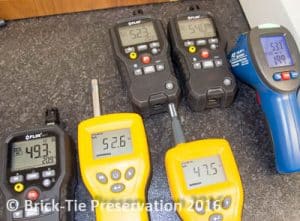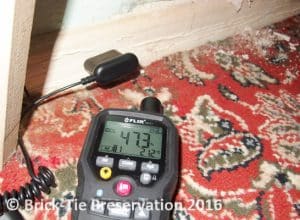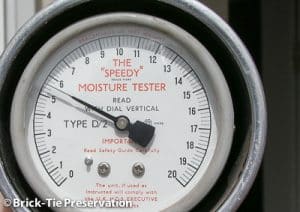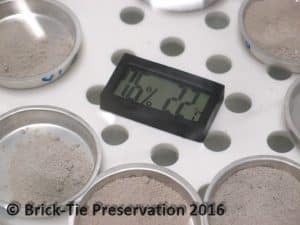How to use a moisture meter.

The above video was made on a real homebuyers damp and timber survey in Harrogate, by our Technical Director Bryan Hindle CSSW CSRT AIOSH. Electronic moisture meters sometimes get a bad press, especially on the internet. However, Bryan demonstrates how to use a moisture meter and one or two of the ways they can sometimes over-read.
Bryan explains how the meters work and shows you some moisture ‘profiling’, which is where moisture meters really shine. This means that they can be used as a very useful tool for any surveyor, who may be trying to gain an insight into the causes of dampness. These meters can be a liability if used incorrectly, so it is essential that surveyors understand the limitations of them. That way they remain a positive tool, rather than a misleading one. It’s surprising how many surveyors don’t know how to use a moisture meter properly. This applies to residential surveyors and even specialist damp surveyors too. Bryan has made it a priority to help train users to make good decisions based on meter reading, rather than bad ones.
When used in ‘pin’ mode these meters work on conductivity. The inverse of this is resistance. You could say that both apply – the better the conductivity of a material the less the resistance to electrical flow. This is indicated on a meter with either an analogue gauge (old ones), lights or numbers (sometimes both). Some also emit beeps and squeaks too if the readings are deemed ”excessive’. In wood and masonry the primary modifier of their original conductivity is moisture. Thus the higher the flow of electricity across the pins – the more water is present (see exceptions in the video and below).
How to use a moisture meter on Wood.

This brings us to the first of the important points about electronic moisture meters. In general they are all calibrated for an average softwood. This means that high, low or medium ‘damp’ readings are based on the presumption, that you are using the meter to measure the moisture content of a bit of wood. If you are doing that, then the readings can be believed as quite accurate (within a couple or three percent). This is known as a quantitative reading. If the meter says the wood has a moisture content of 14% then it really will be about that. It will not be flashing like a beacon or beeping away. That’s because 14% in wood is well below the 20% safety line for fungal decay. Be careful if the wood is stained in any way, or if there are signs of crystalline deposits – some preservative treatments will increase conductivity and throw the readings up a bit (or a lot if the wood is damp too). Also when wood is above it’s fibre saturation point, electronic meters get over excited. So after 28% or so the readings are a little ‘woolly’. That said, it is okay because you have found that the wood is very damp indeed. Something needs fixing quick, if rot and infestation is to be avoided.
Read on for more details on how to use a moisture meter or, call one of our qualified and helpful team on Leeds 265 2752 York 566577 or Sheffield 224 5121 or email us via our contact page
How to use a moisture meter on Masonry and Plaster

However, if you want to use a moisture meter as an aid to diagnosis of damp in masonry or plaster, remember that it is not calibrated for that material. It cannot be so because the wide variety of densities and materials is just too vast. Natural materials like stone can vary within a wall too. A wall is made up of the mortar, the masonry units and the plaster. Any profiling must be done in each separately; never mixed. You cannot compare qualitative readings from different materials. You must not rely on the meter to take quantitative readings. The numbers, colours or sounds refer to ‘relative’ amounts now. You can tell where moisture is present and how much more damp or, much less damp parts of a wall are. The readings are now qualitative. This is important! It is also very useful to a surveyor.
If for example we have a wall with some damp stains. They could be patchy and ill-defined. In the video Bryan mentions ‘profiling’ the wall so that we get a better idea of the distribution of the moisture in it. This is great because in general the higher readings will be nearer the source of the moisture and the lesser readings well, further away. This is basic but very useful as an aid. Visual evidence is important, but the meter may sometimes show that the source of moisture doesn’t follow the stain pattern – very useful. Profiling is done to obtain the distribution and then compare that to what the surveyor sees; the type of construction; location; topography and other factors. A diagnosis can then be reached and will normally be accurate if, the surveyor has used his skill, judgement and equipment correctly. He should know how to use a moisture meter properly.
In the above video Bryan highlights the effects you can expect if you stick ‘pins’ in a wall with metal foil behind the plaster. Watch and you’ll see that this is obviously happening and would not in normal circumstances lead to a misdiagnosis. In fact even a very inexperienced surveyor or amateur would smell a rat – if they obtained very high readings across a wall, with no visual evidence of dampness. Some quick checks as Bryan shows you, will reveal the truth.

If there are quite small amounts of moisture in a wall of dense plaster or brick, then a meter will probably indicate over 20% or so and this will be in the ‘red zone’ or beeps and squeeks may happen. Remember that the meter assumes it is reading timber. It is you, the surveyor, who needs to make an adjustment for the giddy excitement of the equipment. Calm down – 20/24% in plaster is not a problem. Readings over that indicate the likelihood of some ‘free’ water, but if there is really quite a lot of water (say 35% or 60% showing on the meter for example), then this needs investigating. It is crucial not to quote these percentages as a moisture content of a wall. They are qualitative, so if we must quote the numbers these must be delineated by quoting these reading as ‘Wood moisture equivalents” (WME). In other words the figures are simply those which would indicate a quantitative moisture content if they were taken from timber.
Our Technical Director Bryan Hindle doesn’t like this WMD method (it means nothing to our customers), so we tend to quote meter readings from plaster and masonry as ‘high’, ‘moderate’ or ‘low’. The surveyor on site needs to have some flexibility based on the site, the context and other factors. However, as a rough guide we say anything below 20% WME on plaster is low – above that but lower than 25 to 27%%WME is moderate and Over 27% or so can be thought of as high (ish)… once over 35% or so these would be considered a real worry and investigation or some kind of repair or remediation is considered (depending on the surveyors input and client needs).
Could the high readings be due to salts?

If you are getting higher (but not ‘mad’ foil induced levels), on the meter, then the possibility of salt contamination should be considered. This is helpful to the surveyor, rather than a defect or disadvantage of an electronic moisture meter. Why? Because salts are not generally found in high quantities in buildings, unless water has brought them there since construction. Salts are transported in solution, by for example rising damp, penetrating damp and even severe condensation; in the building or voids, especially bricked-up chimneys. The distribution of the readings obtained by good profiling will often locate the ‘evaporation zone’ where the salts are most densly concentrated.
Perversly this may mean that with rising damp for example, the readings may fall with height initially and then get higher, as a wall is profiled, just at the threshold of the rise. The readings may then plummetas you leave the salt contaminated zone. This is know as a ‘salt band’ and is an indicator of a potential rising damp problem. A salt band can manifest for other reasons, but these are well recognised by competent surveyors. Leaks, severe floor/wall junction condensation, salt damp on the faces of chimney breasts and low level penetrating damp, for example.
We hope you have learned a little more on how to use a moisture meter on wood and masonry. Read on for more details or call one of our helpful team on Leeds 265 2752 York 566577 or Sheffield 224 5121 or email us via our contact page
Bryan has made an excellent video of condensation mimicking rising damp, which illustrates how this can very occasionally happen.
Quantitative Moisture measurement in Masonry.
You cannot use any type of electronic moisture meter to get a quantitative measure of the amount of moisture in masonry or plaster. This is for another video, but there are articles which we’ve written on this subject, if you’d like to explore these? There is a great guide on our Technical Director’s preservationexpert blog, which will help you differentiate between the different ways of measuring moisture in masonry, using electronic damp meters, Chemical moisture meters (speedy type), and the gravimetric method too.
Electronic moisture meters for damp surveying


